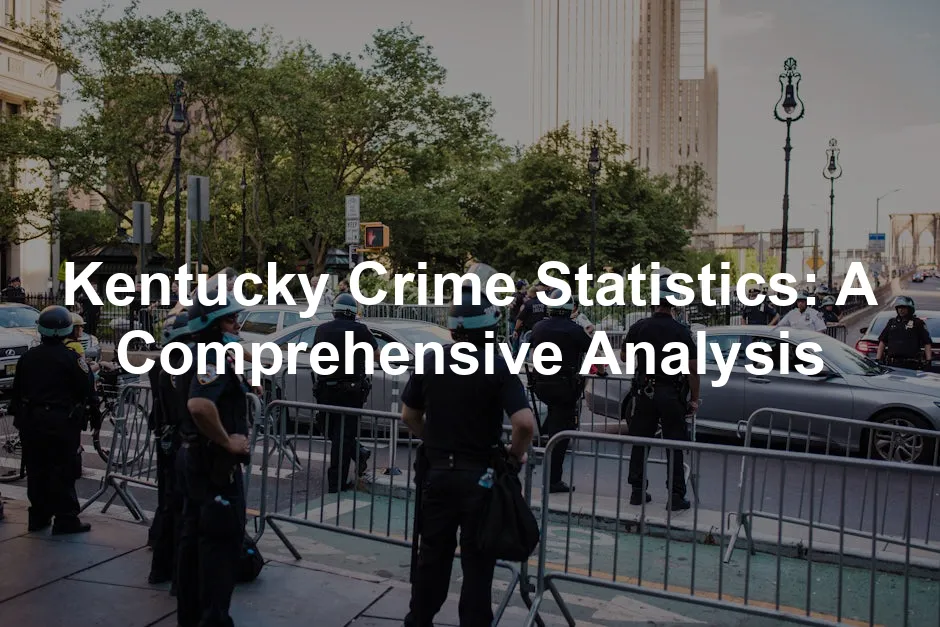Introduction
Kentucky’s crime statistics provide crucial insights for residents, policymakers, and law enforcement agencies. Understanding crime data helps communities gauge safety levels, allocate resources, and develop effective crime prevention strategies. These statistics aren’t just numbers; they reflect the well-being of families and neighborhoods across the state.
This article aims to deliver an in-depth analysis of Kentucky’s crime statistics, exploring trends, implications, and the factors that influence these numbers. We’ll sift through the latest figures to paint a clear picture of crime in the Bluegrass State.
To bolster our findings, we rely on credible sources, including the FBI, Kentucky State Police, and NeighborhoodScout. These organizations gather and publish data that serve as the backbone of our analysis, ensuring that the information presented is both accurate and relevant.
In today’s world, safety is paramount, and investing in a Smart Home Security System can give you peace of mind. With features like real-time alerts and remote monitoring, you can keep an eye on your property from anywhere. Don’t wait until it’s too late; secure your home today!
By the end of this article, you’ll have a comprehensive understanding of crime trends in Kentucky and their significance. Whether you’re a concerned citizen, a local leader, or simply curious, this analysis will provide valuable insights into the state of safety in Kentucky.

Understanding Kentucky Crime Statistics
Overview of Crime Data Collection
Crime data in Kentucky is collected through the Uniform Crime Reporting (UCR) program, managed by the FBI. This program relies on participation from local, state, and federal law enforcement agencies across the nation. The goal is to compile reliable crime statistics that reflect the reality on the ground. Accurate crime statistics are essential for understanding trends and formulating informed policies.
In Kentucky, the Kentucky State Police play a pivotal role in aggregating this data. They compile annual reports that provide detailed insights into crime activities by county, allowing stakeholders to identify areas needing attention.
These reports are invaluable for law enforcement and policymakers. They highlight trends, identify hotspots, and help allocate resources effectively. When communities understand crime patterns, they can make informed decisions about safety measures, community programs, and law enforcement strategies.
Key Crime Indicators
To analyze crime effectively, it’s crucial to understand key terms. Violent crimes encompass offenses such as murder, rape, robbery, and aggravated assault. Property crimes include burglary, theft, and motor vehicle theft. Crime rates are typically calculated by taking the number of reported crimes and dividing it by the population, then multiplying by 1,000.
Understanding these indicators allows residents and officials to gauge safety levels. Higher crime rates can indicate the need for stronger law enforcement presence or community programs. Conversely, lower rates may foster a sense of security among residents.
By breaking down crime statistics into these categories, we can better understand the challenges Kentucky faces and the measures necessary to improve community safety.

To further enhance your safety, consider utilizing a Personal Safety Alarm Keychain. It’s compact, easy to carry, and can be a lifesaver in emergencies. Just pull the pin, and it emits a loud alarm to attract attention. Stay safe out there!
Current Crime Statistics in Kentucky
Annual Crime Overview
Kentucky’s crime landscape is a mixed bag. The state recorded a total of 75,038 crimes recently. Out of these, 9,663 were violent crimes, while property crimes made up a whopping 65,375. This paints a picture of a state where property crime dominates the statistics.
When we look closer at the crime rates per 1,000 residents, the numbers tell a story. The overall crime rate stands at 16.63. Breaking it down, violent crimes account for 2.14 per 1,000 residents, and property crimes clock in at 14.49 per 1,000. This shows that while the violent crime rate is relatively low, property crimes are more prevalent, raising concerns for Kentucky’s residents.
These figures compel us to think about safety and security. What do they mean for everyday life? Are our neighborhoods as safe as we hope? The statistics reveal a need for community engagement and proactive measures to reduce crime.

Speaking of safety, investing in a Home Surveillance Camera System can significantly enhance your security. With features like night vision and motion detection, you’ll have a clear view of your property at all times. Protect your home and family, because you deserve peace of mind!
Breakdown of Violent Crimes
Let’s dig into the nitty-gritty of violent crimes. The numbers show that Kentucky recorded 306 murders. This grim statistic translates to a murder rate of 0.07 per 1,000 residents.
Rape, a serious concern, accounted for 1,527 incidents, reflecting a rate of 0.34. Robbery seems to be a growing issue, with 1,720 reported cases, giving us a rate of 0.38. Finally, assaults topped the list with 6,110 incidents, resulting in a rate of 1.35 per 1,000 residents.
These violent crime statistics raise red flags about community safety. High rates of assault and robbery can create an atmosphere of fear, impacting the quality of life in neighborhoods. Understanding this breakdown is crucial for local authorities and residents alike. It highlights areas needing attention and resources to bolster public safety.

In addition to understanding crime rates, it’s wise to consider personal protection tools. A Pepper Spray for Personal Safety can be an effective deterrent in threatening situations. Carry it with you, and you’ll feel more secure knowing you have a means of protection at hand.
Breakdown of Property Crimes
Moving on to property crimes, the numbers once again reveal a need for concern. Burglary incidents tallied up to 11,044, which translates to a burglary rate of 2.45. Theft, the most common property crime, dominated the statistics, with 44,664 reported cases, equating to a staggering theft rate of 9.90. Lastly, motor vehicle thefts totaled 9,667, resulting in a rate of 2.14.
When we compare Kentucky’s property crime rates to national averages, the disparities become evident. Nationally, the median property crime rate is around 20.0 per 1,000 residents. Kentucky’s rate of 14.49 is significantly lower, suggesting a relative safety in property crime compared to the national picture.
However, the sheer volume of thefts and burglaries indicates that there’s still a long way to go. Communities must focus on preventive measures, such as neighborhood watch programs or enhanced law enforcement presence, to combat these threats effectively.

To further secure your property, consider investing in Motion Sensor Security Lights. They can deter potential intruders and illuminate your property when it matters most. Light up your yard and enhance your safety!
Crime Rate Comparison: Kentucky vs. National Averages
When it comes to crime rates, Kentucky often finds itself in the spotlight. But how does it stack up against national averages? Spoiler alert: There are some surprises!
As of the latest reports, Kentucky’s overall crime rate stands at 16.63 per 1,000 residents. In contrast, the national average hovers around 22.0 per 1,000. That’s right; Kentucky is ahead in the game—but not in every category.
Violent crime rates in Kentucky are measured at 2.14 per 1,000 residents. This is significantly lower than the national median of 4.0 per 1,000. In terms of property crimes, Kentucky’s rate of 14.49 is also better than the national average of 20.0 per 1,000. Let’s break it down further.
The chart below illustrates the crime rate differences across various categories, showcasing how Kentucky measures up against the national averages over the last few years.
| Crime Type | Kentucky Rate (per 1,000) | National Average (per 1,000) |
|---|---|---|
| Overall Crime | 16.63 | 22.0 |
| Violent Crime | 2.14 | 4.0 |
| Property Crime | 14.49 | 20.0 |

This data paints a picture of a state where property crimes dominate, yet violent crimes remain relatively low. This trend has persisted over the years, with Kentucky’s crime rates generally trending downward since peaking in the early 2000s.
The implications? While Kentucky may not be the safest state, its crime rates suggest a degree of stability and safety compared to national averages. Community programs, law enforcement initiatives, and general awareness might be contributing factors to these positive trends.
Crime Trends and Analysis
Long-term Trends in Crime Rates
Looking back at historical data from 1960 to the present reveals a rollercoaster of crime trends in Kentucky. The state has seen significant fluctuations over the decades, primarily influenced by social, economic, and political factors.
The 1960s and 1970s marked a peak, with crime rates soaring across the board. In 1960, Kentucky recorded just under 37,000 crimes. Fast forward to the late 1990s, and this figure had ballooned to nearly 90,000. A combination of factors, including economic downturns and drug epidemics, fueled this growth.
However, the onset of the 2000s brought a shift. Kentucky’s crime rate began to decline. The introduction of community policing and various prevention initiatives helped curb the rising numbers. The COVID-19 pandemic saw a temporary spike in violent crimes, but recent data suggests these rates have started to dip again, indicating recovery and resilience among communities.

To stay prepared for emergencies, consider investing in an Emergency Preparedness Kit. It can equip you with essential supplies for unexpected situations. Being prepared is half the battle!
Emerging Crime Types
As we analyze current trends, it’s crucial to highlight the emergence of specific crime types. Human trafficking and drug offenses have surged in recent years.
Human trafficking cases have garnered attention, spurring law enforcement to ramp up training and awareness initiatives. This rise in reported cases is thought to be linked to better detection and reporting mechanisms, rather than an outright increase in incidents.
Drug offenses, particularly related to opioids, have also seen a sharp rise. The implications for law enforcement are substantial. They must adapt to these evolving crime landscapes while also addressing community safety concerns.
The rise in these crime categories calls for targeted community programs and law enforcement strategies. Local agencies are working to educate citizens, enhance reporting mechanisms, and ultimately combat these growing issues.
In summary, while Kentucky’s overall crime rates may be trending downwards, the emergence of specific crime types demands attention. The state must remain vigilant and proactive to ensure a safe environment for all its residents.

Impact of Legislation on Crime Rates
Recent legislation, particularly House Bill 5, has stirred significant discussion in Kentucky. This bill aims to address rising crime rates by imposing harsher penalties for various offenses. Supporters argue that it will enhance public safety. However, critics raise eyebrows, questioning the need for such measures.
Expert opinions on House Bill 5 vary. Pam Thomas, a senior fellow at the Kentucky Center for Economic Policy, asserts that crime data does not support claims of a crime wave. In fact, Kentucky’s violent crime rate has decreased by 5% since 2012. It now stands 44% lower than the national average. Thomas notes that recent FBI data reveals a 19% drop in violent crimes from 2020 to 2022.
Moreover, the robbery rate has declined by 23% in the same period, contradicting the narrative that harsher penalties are necessary. This decrease raises questions about the effectiveness of increased incarceration as a solution. Lawmakers might be overlooking the positive trends in crime statistics.
Supporters of House Bill 5 often cite pandemic-era spikes in crime as justification for tougher measures. Yet many experts argue that these spikes were temporary. They suggest that focusing on community programs and preventive measures might yield better results than simply increasing penalties.
In essence, while the intention behind House Bill 5 is to enhance public safety, the underlying data presents a more nuanced picture. The effectiveness of the bill remains debated among lawmakers and experts alike. A balanced approach that considers both legislation and community engagement may ultimately serve Kentucky better.
Safety and Crime Prevention
Public Perception of Crime in Kentucky
Crime statistics significantly shape public perception of safety in Kentucky. When people hear about rising crime rates, anxiety often follows. However, understanding the context behind these statistics can provide a clearer picture.
Many residents often feel unsafe, largely influenced by media reports highlighting violent crimes. This perception can lead to a sense of helplessness. Yet, data reveals that crime rates in Kentucky are generally lower than national averages. Education and awareness are essential in combating these misconceptions.
Community initiatives play a vital role in reducing crime. Neighborhood watch programs, community policing, and local outreach efforts foster trust between residents and law enforcement. When communities collaborate, they create safer environments.
Moreover, local events aimed at raising awareness about crime prevention strategies help build resilience. Many Kentucky towns have launched campaigns educating residents on safety measures. These initiatives not only reduce crime but also empower citizens to take an active role in maintaining community safety.

As part of ensuring safety, it’s wise to consider personal defense tools. A Self-Defense Keychain Tool can be a discreet yet effective way to protect yourself in unexpected situations. Stay alert and equipped!
Top Safest Cities in Kentucky
Kentucky boasts several cities where residents can feel secure. Here’s a look at the top ten safest cities in the state, based on crime statistics:
- Ekron: With a low violent crime rate and active community engagement, Ekron stands out.
- Buckhorn: Known for its tight-knit community, Buckhorn emphasizes safety and cooperation.
- Vicco: This small city boasts minimal crime incidents, thanks to proactive local programs.
- Virgie: Residents enjoy a peaceful environment, with law enforcement actively engaged.
- Bremen: A safe haven with a low crime rate, Bremen fosters a sense of community.
- Warfield: Safety initiatives have helped Warfield maintain its reputation as a safe city.
- Nebo: With a strong community focus, this city ensures residents feel secure.
- Bonnieville: Crime rates here are notably low, contributing to a serene atmosphere.
- Woodburn: Residents benefit from community policing efforts and strong local ties.
- Arlington: Known for its safety, Arlington actively engages residents in crime prevention.
These cities demonstrate that community efforts and collaboration with law enforcement play a crucial role in maintaining safety. By prioritizing proactive measures, residents in these areas can enjoy a peaceful living environment. Emphasizing the importance of community involvement can help reduce crime rates across the state.
Resources for Residents
Staying informed about local crime is essential for community safety. Fortunately, Kentucky offers numerous resources for residents to stay updated. Neighborhood watch programs are an excellent starting point. These grassroots initiatives empower residents to keep an eye on their communities, report suspicious activities, and foster a sense of camaraderie.
The Kentucky State Police also provide valuable resources. Their website features detailed crime reports and statistics, helping residents understand the safety landscape in their areas. For those interested in more localized information, many counties and cities publish crime maps. These tools allow residents to visualize crime trends and incidents in real time, making it easier to stay alert.
Additionally, local law enforcement agencies often host community meetings. These forums provide opportunities for residents to engage with police officers, voice concerns, and learn about crime prevention strategies. Citizens can also subscribe to crime alerts via email or text, ensuring they receive the latest updates on incidents that may affect their neighborhoods.
If you ever feel unsafe or notice something suspicious, don’t hesitate to contact local law enforcement. They are there to help and ensure the safety of the community.
FAQs
What are the most common crimes in Kentucky?
In Kentucky, property crimes dominate the statistics, with theft being the most prevalent. According to recent data, theft accounts for a staggering 44,664 incidents, making it a significant concern for residents. Other common property crimes include burglary, with 11,044 reported cases, and motor vehicle theft, which totaled 9,667 incidents. On the violent crime side, assaults lead the pack with 6,110 occurrences, followed by robbery at 1,720 and rape at 1,527. While these violent crimes are concerning, it’s crucial to note that Kentucky’s violent crime rate is lower than the national average.
How does Kentucky’s crime rate compare to other states?
When comparing Kentucky’s crime rate to neighboring states, it’s important to highlight the state’s overall safety. Kentucky’s violent crime rate is approximately 2.14 per 1,000 residents, significantly lower than the national average of around 4.0. In terms of property crime, Kentucky’s rate stands at 14.49 per 1,000, while the national average hovers around 20.0. This means that, on the whole, Kentucky is faring better in terms of violent crime, but property crimes remain a key focus area for local law enforcement and communities.
What steps can individuals take to protect themselves from crime?
Individuals can take several practical steps to enhance their personal safety. Firstly, being aware of your surroundings is crucial. Avoid distractions like phone use when walking in public spaces. Secondly, consider installing security systems at home, including alarms and cameras. Participating in neighborhood watch programs is also highly beneficial. These programs create a sense of community and encourage residents to look out for one another. Finally, always report suspicious activities to local law enforcement. Your vigilance can make a significant difference!
Are crime rates increasing or decreasing in Kentucky?
Recent data suggests that Kentucky’s crime rates are experiencing a general decline. While there was a temporary spike during the COVID-19 pandemic, recent statistics show a 19% drop in violent crime from 2020 to 2022. Experts note that while property crimes remain a concern, many categories, including robbery, have seen a downward trend. This indicates that community efforts and law enforcement strategies are having a positive impact on overall safety.
How can I access Kentucky crime statistics?
Accessing reliable crime statistics in Kentucky is straightforward. The Kentucky State Police website is an excellent resource, offering annual reports that detail crime statistics by county. Additionally, the FBI’s Uniform Crime Reporting (UCR) program provides comprehensive data available for public access. For localized crime data, many cities and counties publish their own crime reports and maps, often hosted on their official government websites. By utilizing these resources, residents can stay informed about crime trends and statistics in their areas.
Please let us know what you think about our content by leaving a comment down below!
Thank you for reading till here 🙂
For a deeper dive into the implications of crime statistics in Kentucky, check out our detailed analysis on Kentucky crime statistics.
All images from Pexels




